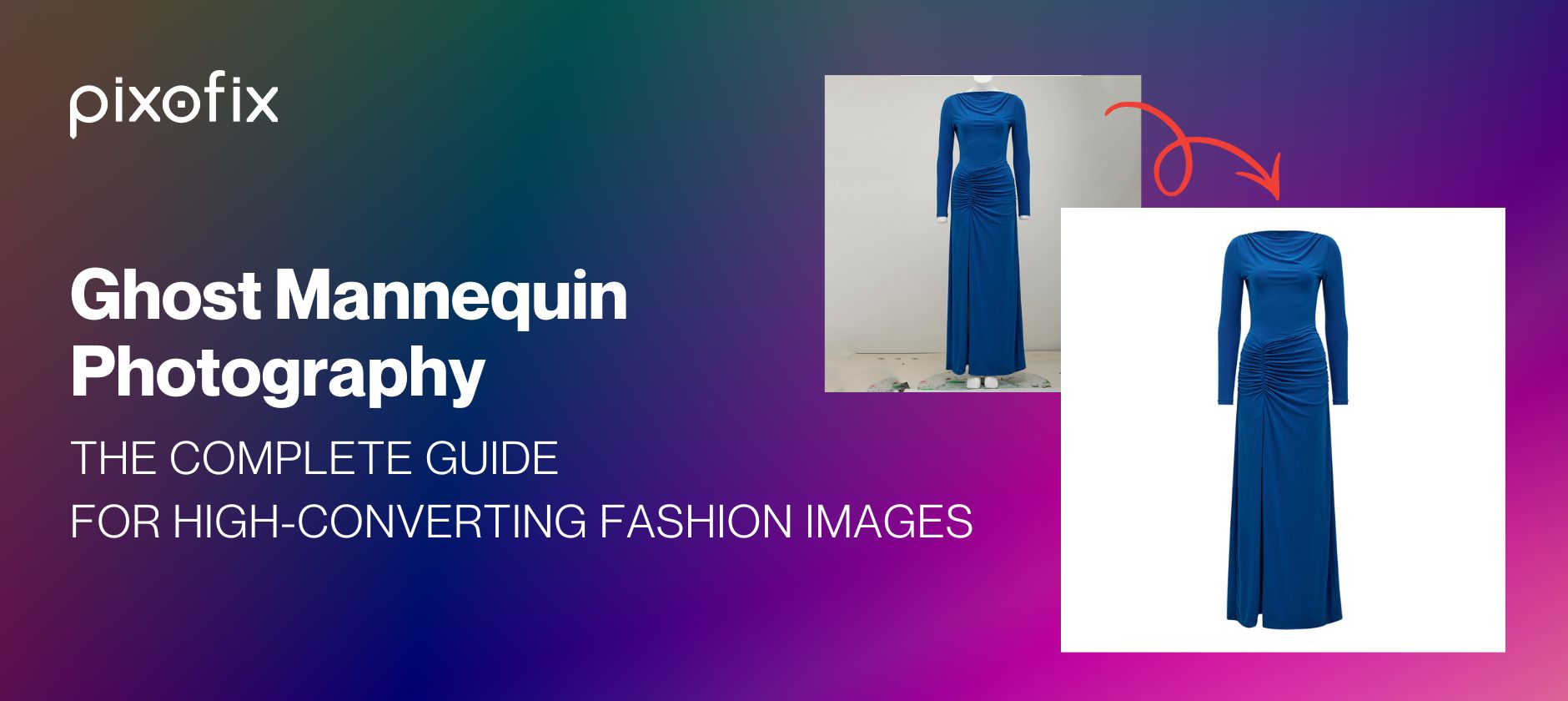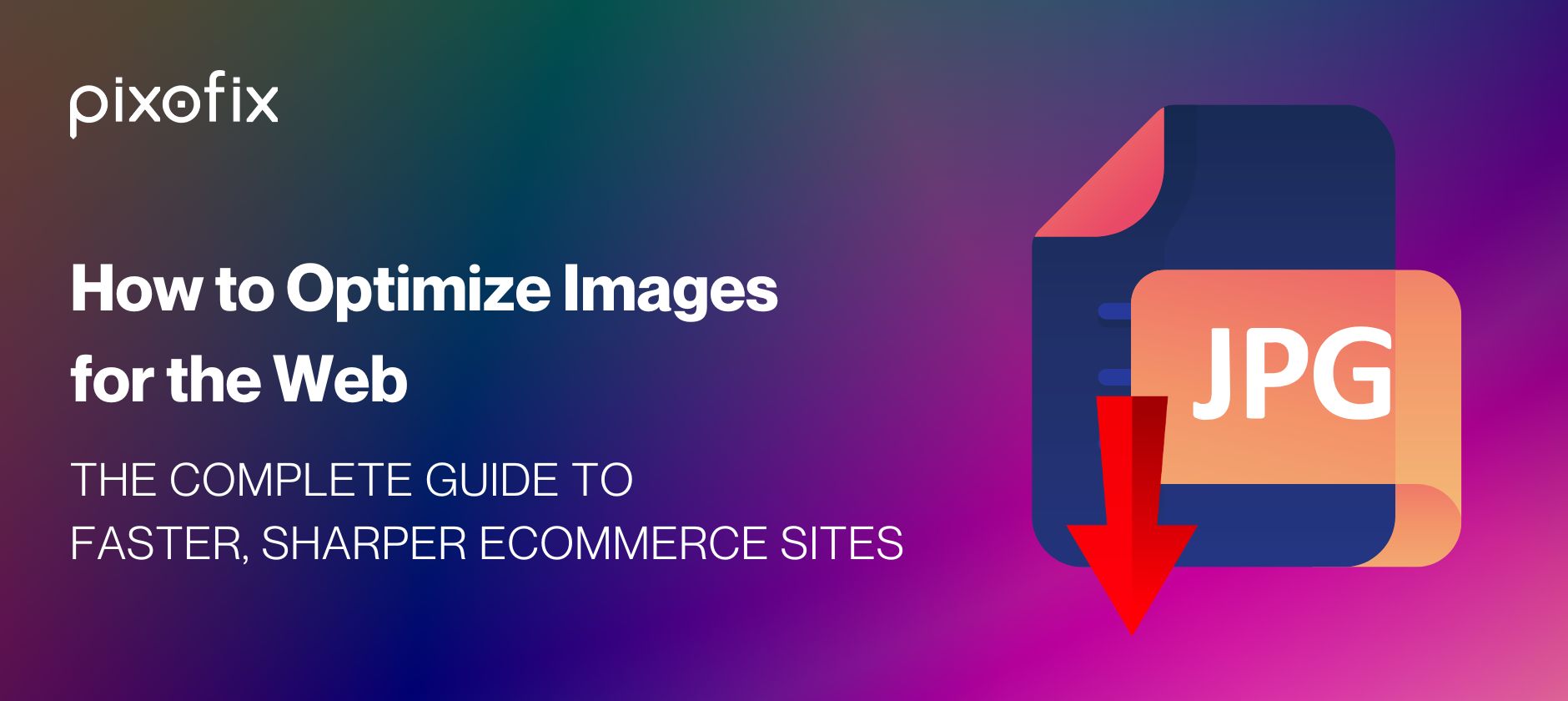Why Ghost Mannequin Photography Matters
Impact on E-commerce Sales
On product pages, your visuals do the selling. Ghost mannequin photography creates the illusion of a floating, perfectly-shaped garment — no distracting background, no awkward hanger wrinkles. That elevates perceived quality. When buyers see fit and form clearly, they’re more confident clicking “Add to Cart.”
This style also feeds the speed economy of ecommerce. With clean, repeatable images, you can launch collections faster and scale catalogs without visual chaos. Brands that invest here cut returns and see lift in both conversion rate and average order value.
Enhancing Brand Aesthetics
A clean ghost mannequin style becomes part of your visual identity. Done right, it feels consistent, understated, and premium. That’s crucial for fashion brands where design sells the dream. Every product shot should feel like it's from the same world — not stitched together from different campaigns.
When that consistency breaks, it signals brand disarray. When it clicks, shoppers feel immersed in something intentional. Ghost mannequin shots build brand gravity. They're not just functional, they're strategic.
Consumer Preferences in Online Shopping
Online shoppers want detail and clarity. But more than that, they want to imagine — how will this look on me? Ghost mannequin photography bridges that gap. It’s more relatable than flat lays, more polished than model photography can sometimes be, and more scalable than video for every SKU.
By showing garments in shape, without the distraction of models, it centers the product. That aligns with how modern shoppers browse. Fast. Visual-first. Scroll-happy. If the product doesn’t speak instantly, they bounce.
Understanding Ghost Mannequin Photography
Definition and Purpose
Ghost mannequin photography is a post-production technique where garments are shot on a mannequin, then the mannequin is edited out to create a floating effect. The result: the product keeps its form and structure, but the focus stays on the garment alone.
It’s made for ecommerce. It removes visual clutter and standardizes how every product is presented. The end goal isn’t just aesthetic polish — it’s visual clarity without compromise.
Key Benefits for Fashion and Product Retail
For apparel brands, fit is everything. Ghost mannequin highlights silhouettes, textures, and construction details while keeping the viewer's focus exactly where it should be — on the product. For accessories or hard goods, the same logic applies. The technique gives shape context, minus unnecessary props.
Compared to flat lay or hanger shots, this method levels up perceived value. And because the workflow is repeatable, it reduces shoot complexity. With post-production pros like Pixofix involved, teams get uniform, high-quality images at scale without sacrificing turnaround time.
Equipment and Setup for Ghost Mannequin Photography
Choosing the Right Mannequin
Start with a mannequin that matches your brand’s fit intent. It needs to reflect your sizing standards, posture, and garment type. Seamless torsos work best for clean removals in post.
Some brands invest in “ghost mannequins” with detachable sections — like removable necks, sleeves, or chest panels. These make the editing process smoother since you can capture interior garment details in secondary shots.
Recommended Camera Gear
A full-frame DSLR or mirrorless camera gives the clarity and dynamic range you need, especially for textured fabrics. Pair it with a sharp 50mm or 85mm lens for accurate proportions and minimal distortion.
Shoot tethered if possible. It lets you monitor shots in real time and adjust on the fly. And always shoot in RAW. You’ll need as much latitude as possible for retouching later, especially when stitching layers or color grading to match brand tones.
Lighting Techniques for Optimal Shots
Lighting should be soft, even, and shadow-controlled. Use a key light with a large softbox overhead or slightly off-center for definition. Then fill shadows with reflectors or secondary lights to avoid harsh contrast.
The goal isn’t drama. It’s consistency. Get your light ratios dialed in so whites stay white, and dark fabrics retain detail. Avoid spill on the backdrop — it makes the post-production masking harder and increases cleanup work.
Steps to Capture Ghost Mannequin Images
Preparing the Garment
Every wrinkle, fold, or uneven cuff will show up 10x more under studio lights. So start with a perfectly steamed piece. Pin, clip, and tape the garment on the mannequin to create clean lines and proper fit.
Shoot backup angles too — especially for layered garments or anything with complex collars. These will be critical during compositing.
Posing the Mannequin
Think structure. You’re not posing for emotion, you’re framing for clarity. Align hems, make sure sleeves fall naturally, and adjust garment tension to show the real silhouette.
For invisible mannequin shots, capture extra frames of the garment’s inner areas — necklines, hoods, or jacket linings. You’ll use these in post to replace the mannequin body.
Photography Best Practices
Use a tripod. Stick to ISO 100. Dial in those camera settings so every shot is sharp, color-accurate, and free from movement blur. Keep height and angle consistent across shoots — one skewed frame can throw off a production line of edits.
Label your shots clearly on import. Use consistent naming for front, back, and detail views. That’s not just workflow hygiene. It minimizes retouching friction and speeds up QC for partners like Pixofix managing high-volume edits.
Post-Processing Workflow for Ghost Mannequin Images
Importing and Organizing Files
Start by importing into Lightroom or Capture One for a primary pass. Color-correct and apply base exposure tweaks in batches. From there, drop selects into Photoshop with layers intact.
Structure is everything here. One loose file name or missing angle can bulk-break a retouching queue. Sort assets into garment folders before anything hits the studio’s retouching pipeline.
Creating Layers in Photoshop
Layer stacking is where ghost mannequin editing begins. Combine mannequin shots with interior details into one composite file. Each garment part — neck, sleeve, back panel — needs its own layer for detailed masking.
Use smart objects where possible. It keeps edits non-destructive and allows for easier tweaks once the composite comes together.
Selecting and Masking the Garment
Precision is the goal. Use the Pen Tool or Select Subject to isolate the garment. For tricky textures like lace or sheer fabrics, refine manually. Don’t rely on AI selection tools entirely — they speed things up, but miss nuance.
Pixofix uses a hybrid approach here. AI for bulk isolation. Manual refinement for edge discipline. That’s how they keep image quality high even at scale.
Refining Edges and Adding Shadows
After isolation comes finesse. Feather sharp edges just slightly to avoid a hard cutout look. Use layer masks to blend interior and exterior shots seamlessly. Then, simulate natural shadows under armpits, hems, or collars to give the image weight.
Shadows aren’t just realism. They’re storytelling. They hint at a three-dimensional product and say “this is real, not computer-generated.” That subtle detail builds trust in shopper minds.
Finalizing the Image
Crop the image to fit your store’s dimensions. Standardize canvas size and ensure alignment across all variants. Zoom in. Double-check seams, edges, and color accuracy. Nothing screams careless faster than a stitched-together product gone sloppy at pixel-level.
If you’re working with a retouching partner like Pixofix, they’ll usually run these through a final quality pass — matching your brand's visual tone, correcting global color shifts, and delivering web-optimized assets ready for launch. No bottlenecks. Just fast, consistent production-ready images.## Before-and-After: Transformation of Ghost Mannequin Images
Visual Case Studies
The difference between a raw mannequin shot and a polished ghost mannequin image is night and day. At first glance, the raw photo feels utilitarian — there’s shape, but it’s masked by visual baggage. Seams pulled awkwardly. Mannequin ridges showing through sheer fabric. Shadows in all the wrong places.
Now swipe to the final composite. The mannequin is gone. The garment floats in space, sculpted and pristine. The shape is intentional. Necklines feel clean and symmetrical. Sleeves fall with real-world weight, but without distraction. These aren’t just edits — they’re enhancements that help customers see the piece as it’s meant to be worn.
Teams like Pixofix often showcase before-and-after sets during onboarding — not as a flex, but as a shared vocabulary. It helps brands visualize what needs to be fixed, not just filtered.
Key Improvements Illustrated
What does retouching actually correct? Here’s what you’ll often see change from raw to final:
- Garment symmetry aligned (hems, sleeves, collars)
- Wrinkles smoothed without over-blurring texture
- Mannequin removal that preserves shape, not flattens it
- Inner garment areas composited in (necklines, straps, hoods)
- Shadows added for realism — never copy-pasted, always custom-built
These edits aren't just polish for polish’s sake. They're performance-driven. A well-constructed ghost mannequin image lifts your brand perception, reduces return rates, and increases zoom behavior on product pages. The ROI lives in the pixels.
Common Mistakes in Ghost Mannequin Photography
Errors in Garment Preparation
No amount of Photoshop can fix a poorly prepped shirt. If collars cave in or one sleeve is twisted, every shot will carry that imperfection forward. One of the biggest missteps? Not steaming thoroughly. Creased fabric doesn’t just look sloppy, it complicates masking in post.
Another common issue — bad pinning. Clothes should be tightened on the mannequin to reflect true fit. But over-clipping creates tension lines; under-clipping makes clothes droop. The rule: pin for silhouette, not for speed.
If you’re working with a retouching studio like Pixofix, clean structure is non-negotiable. Their post team can composite almost anything — but they can’t invent proper drape if it’s not there to begin with.
Poor Lighting Choices
Too harsh, and your garment turns into a highlight-blown mess. Too soft or directional, and detail gets swallowed in shadows. Ghost mannequin photography needs balanced lighting that respects shape but doesn’t overwhelm it.
Mistake one? Ignoring color temperature. If your lights aren’t white-balanced properly, colors will shift — and correcting that in post can degrade detail. Mistake two? Inconsistent setups. Slight layout changes from shot to shot can create lighting differences that break visual flow on your site.
The high-performing studios treat lighting like a math equation. Same gear, same placement, every time. It's the difference between uniformity and chaos.
Inadequate Post-Processing Techniques
Sloppy masking is the fastest way to kill the illusion. You’ll see it when garments look like they’ve been “cut out” with kitchen scissors — jagged edges, blown textures, static drop shadows that don’t match garment curves.
Then there’s over-smoothing. Retouchers sometimes blur fabric detail trying to remove wrinkles. But ecommerce shoppers want to see texture. They zoom. Overblurring just creates distrust.
This is where hybrid teams like Pixofix earn their edge — they use AI for speed, but layer in manual refinement where it matters. Edges. Texture. Color integrity. That balance keeps volume high and quality intact.
Optimization Tips for Ghost Mannequin Photography
Streamlining Your Workflow
Speed and scale win in ecommerce. But only if your workflow is tight. Start with a shot list — exact angles, lighting setups, filenames. Then, build a studio checklist to keep every shoot session predictable and repeatable.
Use tethered shooting to review in real time. Flag issues before they snowball. Label files consistently. When you hand off to a retouching partner like Pixofix, that clarity translates into faster turnarounds and fewer rounds of revisions.
Even mid-sized teams should set up automations around import, sort, and export. Lightroom or Capture One can speed-tag selects. Folder presets can trigger batch exports. Every second saved at this stage compounds downstream.
Enhancing Image Quality
Start with precision in-camera. That means sharp focus on garment details, clean backgrounds, and correct white balance. But the real leveling-up happens during post.
Use color grading subtly to reinforce your brand look — not every image needs to be clinically neutral. Slight warmth or softness can go a long way if it fits your tone. Avoid generic filters though. Ecommerce imagery should feel real, not stylized.
Refine masks to preserve complexity — especially around laces, knit edges, or loose strings. True quality shows up when the fine details hold up at 100% zoom.
Consistency in Branding
Shoppers read your store like a magazine. The moment one product image feels off-style — too dark, differently cropped, weird shadows — it disrupts their experience.
Build a visual guideline that defines image scale, garment positioning, shadow weight, even background hue. Use it religiously. Without this, your catalog turns into a patchwork of styles.
Retouching partners like Pixofix help enforce this consistency through embedded QC steps. They align every image with your brand’s design tone, not just technical specs. That’s how product pages feel composited, polished, and intentional — not like every photo came from a different supplier.
Metrics to Measure Impact and Quality
Turnaround Time Analysis
It’s tempting to judge a photo team just on speed. But smart brands track average turnaround time across batches — not just per file. That reveals friction points. Are delays coming from shoot prep? Review cycles? Retouching queues?
With a partner like Pixofix, you get transparency into timing per batch and per SKU. That helps you plan drops better, sync with your ecommerce launches, and keep merchandising schedules on track.
A 2-day delay might seem small. Until it backs up your product launch and turns into missed revenue.
Quality Score Benchmarks
Define what “quality” actually means for your team. It could be edge precision, chromatic accuracy, or interior detail visibility. Then create a quality rubric and score random samples from each batch.
Some teams use five-point QC scores based on visual criteria. Others work with their retouchers to build feedback loops directly into delivery. Pixofix, for instance, tags images that might need review — saving your team from hours of spot-checking.
In short: make quality measurable. Not subjective.
Customer Engagement Metrics
The final judge? Your shopper. Track how ghost mannequin images change engagement metrics like:
- Zoom rate on product images
- Time spent on product page
- Conversion rate per SKU
- Return rate variability
Even subtle improvements can shift KPIs. A sharper neckline might lead to more zooms. Better color consistency? Fewer comments like “didn’t look like the photo.”
Photography should push business results. And those data signals are your compass.
Comparison: Ghost Mannequin vs Flat Lay Photography
Pros and Cons of Each Method
Ghost mannequin photography wins on realism and form. It shows how fabric falls, how a piece fits in space — almost model-like, without the distractions. It’s scalable and it’s immersive.
Flat lay, on the other hand, is easier to execute and lends itself to editorial or stylized looks. It works well for certain product types — kidswear, accessories, loungewear — where shape isn't as critical.
Here’s the tradeoff:
Ghost Mannequin:
✓ Detailed shape, premium look
✓ Best for apparel with structure
✗ Requires more post work
✗ Needs controlled studio workflow
Flat Lay:
✓ Fast to shoot
✓ Good for creative layouts
✗ Lacks depth and fit context
✗ Can feel casual or low-end if not styled precisely
Situations Best Suited for Each Style
Use ghost mannequin for:
- Structured garments: blazers, dresses, outerwear
- Launches that need hero-level visual consistency
- Product pages that require multiple variants with clean flow
Use flat lay for:
- Accessories: bags, scarves, belts
- Seasonal lookbooks or themed landing pages
- Lifestyle-leaning brands with more flexible image language
Some brands mix both, using ghost mannequin for PDPs and flat lays for social or email. That’s the hybrid model. And it works — as long as each style serves a specific purpose and stays visually aligned with the brand voice.## Tools and Software for Ghost Mannequin Photography
Essential Editing Software
Photoshop still owns the throne for ghost mannequin editing. Its layer control, masking precision, and compositing flexibility are unmatched — especially when working with multiple garment angles. Use it for stitching necklines, blending shadows, and refining contours at a pixel-perfect level.
Capture One is a go-to for studio tethering. It nails color accuracy and batch exposure tweaks before anything moves into deep edits. Its real-time preview speeds up QA on set, making it easier to catch lighting flaws before post.
Lightroom works well for initial imports and global adjustments, especially when dealing with large volumes. But it’s not ideal for detailed compositing. Think of it as the prep kitchen — not the plating station.
Some teams are folding in generative AI like Adobe’s Content-Aware Fill or background replacement tools for speed gains. But these should supplement, not replace, human-led editing. Texture refinement, realistic shadows, and garment volume still need a trained eye.
For ecommerce retailers handling hundreds of SKUs, the real leap comes from workflow pairing — expert retouchers like Pixofix integrate directly into your tech stack, combining AI speed with manual finesse. That hybrid model gets you clean, on-brand images ready to publish, fast.
Recommended Online Resources
Learning ghost mannequin editing isn’t just about tutorials. It’s about exposure to processes that scale.
Start with Adobe’s official training for Photoshop — their masking and composite videos offer solid foundations. Then explore content from studio pros who actually shoot and edit apparel daily. PRO EDU and Karl Taylor Education go deeper into lighting control and garment form — the stuff you won’t get from beginner YouTubers.
For workflow strategy, the Pixofix blog breaks down high-volume editing best practices, featuring examples from fashion studios working at ecommerce speed. It’s less about flashy before-and-afters, more about how to systematize quality.
Forums like r/PostProcessing or commercial photography Discord groups are also valuable. You can ask, “What’s the best way to shadow a floating hoodie?” and get three answers from people who do it for a living.
When the stakes are high — brand launches, marketplace integrations, cross-border shoots — it makes sense to work with a partner like Pixofix. They don’t just retouch. They optimize your image pipeline, tweak guidelines with your team, and give feedback loops that level up every campaign.






.png)

.png)
